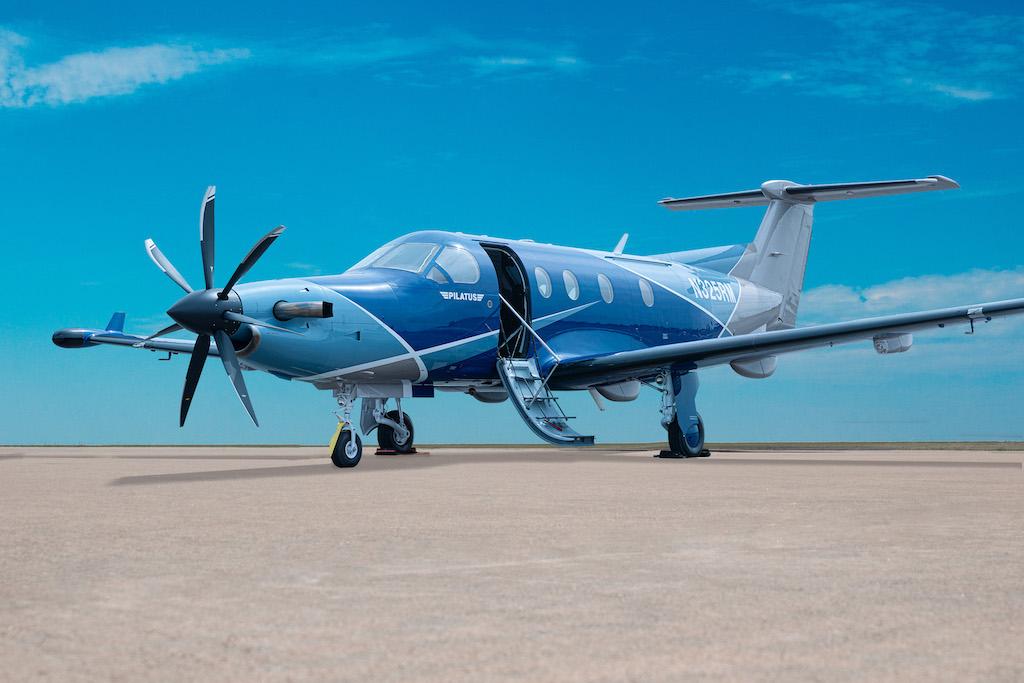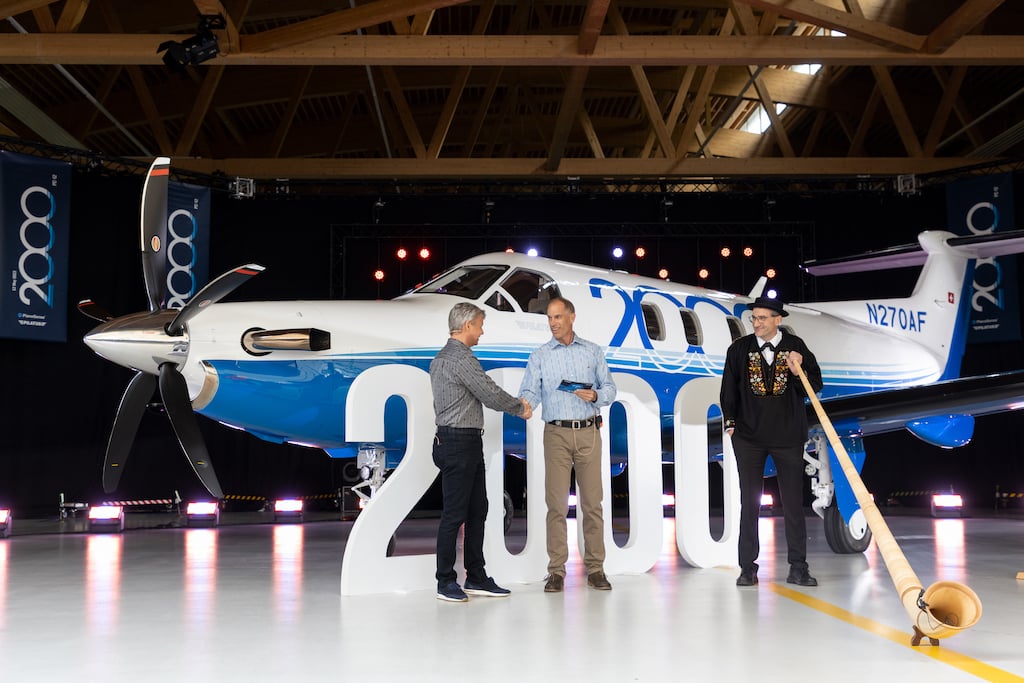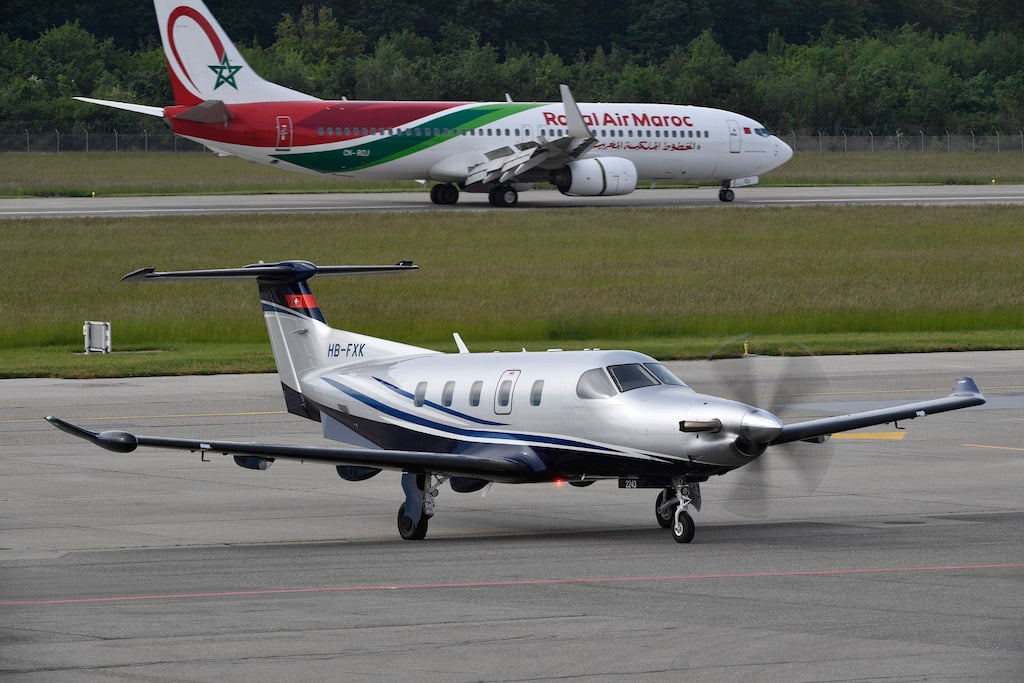
Exterior photo of a legacy PC-12/45 fitted with MT-Propeller's 7-blade prop.
Buyers interested in comparison shopping against the Pilatus PC-12 may have to wait for an aircraft that hasn’t entered service yet, advises Leviate Air Group President Randall Mize.
Until Textron Aviation’s new Beechcraft Denali enters service, currently planned in 2025, no other aircraft type truly competes with the venerable PC-12 turboprop single, says Mize, an ATP-rated captain with multiple business jet type ratings. He should know, having once owned a PC-12 as a “passion project” and participated in ferry flights to source and deliver PC-12s for customers across multiple continents.
“The PC-12 offers a combination of unique capabilities that no other aircraft type can match at the same operating cost,” Mize tells BCA. “The exceptional performance at low operating cost ensures that year after year, the PC-12 maintains unmatched value retention. Buyers know that the PC-12 is a highly capable machine that experiences less depreciation compared to other types of aircraft.”
Pilatus Delivery Milestone

Developed by Swiss manufacturer Pilatus Aircraft in the late 1980s, the PC-12 was certified by the Swiss Federal Office for Civil Aviation in March 1994 and by the FAA in July of that year. In May 2023, Pilatus celebrated the delivery of the 2,000th PC-12 at its headquarters in Stans, Switzerland, handing over the milestone airplane to fractional ownership company PlaneSense, a long-time customer.
Capable of carrying up to nine passengers, or 10 if the co-pilot’s seat is available, legacy PC-12s (designated PC-12, PC-12/45 and PC-12/47) were powered by a 1,200-shp Pratt & Whitney Canada PT6A-67B engine. The cockpit was fitted with the Bendix/King EHI-40 electronic flight instrumentation system displayed via cathode-ray tubes, a KLN-90B GPS receiver and electromechanical instruments. The PC-12 NG (PC-12/47E) variant in 2008 came with more powerful PT6A-67P engine, Honeywell’s Primus Apex integrated avionics system, new winglets, and a digital cabin-pressurization system.
At the recent EAA AirVenture Oshkosh fly-in convention, Honeywell exhibited a testbed PC-12 fitted with its fifth-generation Honeywell Anthem flight deck, which has been designed for advanced air mobility as well as GA aircraft.
Latest PC-12 Model

Pilatus announced the PC-12 NGX at NBAA-BACE in October 2019 and delivered the first model in May 2020. Powered by a FADEC-controlled P&WC PT6E-67XP engine rated at 1,845 shp, its max cruise speed is 290 ktas. Max range with four passengers, a single pilot and NBAA IFR reserves is 1,803 nm, Pilatus says. The NGX requires a takeoff distance of 2,485 ft. at MTOW (10,450 lb.) in ISA sea-level conditions to clear a 50-ft. obstacle.
The 1995 factory-new list price of a legacy PC-12 was $2.19 million, according to the Aircraft Bluebook. Its factory-new average equipped price—the way it left the manufacturer or a completion center—was $2.55 million. The sticker price of a PC-12 NG in 2008 was $3.35 million; its average equipped price was $3.85 million.
The factory-new list price of a PC-12 NGX this year is $4.8 million, but its average equipped price weighs in at $6.028 million, according to the Bluebook. This is the same as its average retail price, which is the market price for an average, mid-time used aircraft.
As of mid-August, there were 1,951 PC-12s in service, stored or in the possession of a third-party, including 931 NG and 273 NGX models, according to the Aviation Week Fleet Discovery Database. Most PC-12s (1,327) are based in North America, with 246 residing in Western Europe and 126 in Latin America.
There were 57 listed PC-12s and three off-market airplanes for sale in late July, according to Leviate’s market intelligence team. Of these, 31 were PC-12 NGs, 24 were legacy PC-12s and five were PC-12 NGXs. Leviate, based in Dallas, is an International Aircraft Dealers Association accredited dealer, aircraft charter and management services company.
Pre-owned PC-12 NGs can range in price from the high $3 millions for an aircraft with a few hundred hours left until overhaul, to the mid-$4 millions for a low-time, turnkey airplane, Mize says. Models delivered in 2014-16 can reach $5 million in the current market and newer models are priced well into the $5-million range. Latest PC-12 NGXs were stabilizing in the $6-million range after climbing past $7 million.
The lowest price range of legacy PC-12s is $2 million to $3 million, assuming an airplane has plenty of hours remaining before it is due for an engine overhaul.
Upgrades Improve Value
Germany’s MT-Propeller holds FAA and EASA supplemental type certifications for 5- and 7-blade propeller upgrades on legacy and newer PC-12s. Installation of a “Silent 7” propeller reduces required take-off length by approximately 20% compared to original certified data, improves climb and cruise performance, and lowers noise level inside and outside of the cabin, the company says.
“Well-equipped legacy PC-12s can trade in the high-$3 millions if they have a full Garmin glass cockpit, recent paint and interior, fresh inspections, and an upgraded 5- or 7- blade prop,” Mize said. “For example, our company recently imported a 2003 PC12/45 from India, invested in upgrades including Garmin avionics, new paint, new interior, and 7-blade prop, and with those upgrades achieved a sale price in the high 3s.”
While Textron Aviation’s Denali may prove to be “a formidable challenger,” the PC-12 holds a unique position in the market because it offers a cabin comparable to a midsize jet, the operating cost of a single-engine turboprop, 1,500 nm range, a pallet-sized cargo door and takeoff and landing capabilities on unimproved surfaces, Mize says.
Viable alternatives for buyers who don’t require that combination of features include the Embraer Phenom 100/E or Cessna Citation M2 light jets if they don’t need as much range and cabin; the Bombardier Learjet 45XR if they are not sensitive to higher crew and operating costs; or the Beechcraft King Air B200/350 for those who feel strongly about having a second engine, Mize says.
A Spacious Interior

A PC-12 NGX cabin has a flat floor and is 16 ft., 11 in. long, 5 ft. wide, and 4 ft., 10 in. high. Cabin volume is 330 ft.3. The volume of the baggage compartment, located in the aft cabin next to the cargo door, is 40 ft.3.
Most of the executive PC-12s that Leviate Group sees have a 6-seat interior, with 4-place club seating forward and two forward-facing seats aft. Some PC-12s have a second row of two forward-facing seats in the aft cabin, enabling an 8-place cabin. The additional two seats can cost around $50,000 to install if the aircraft is not already equipped, Mize says.
Passengers value the cabin’s size, “especially for taller passengers upgrading from a very light jet such as the Phenom 100,” Mize says. “Passengers also love the range of the aircraft compared to a very light jet, which usually requires a stop for missions longer than 1000 nm.”
He adds “the PC-12 has a flat floor, which is not only unusual for a turboprop, but it’s also rare even in the midsize world. The easily accessible baggage compartment also wins praise from passengers.”
PC-12 basic maintenance intervals are 300 flight hr., 600 flight hr., 300 flight hr./12 months, 600 flight hr./12 months, 1,200 flight hr./12 months and 2,400 flight hr./24 months. Annual inspections range in price from $40,000-$60,000, with the 10-year inspection costing $80,000 in some cases, Mize says.
Also every 10 years, an aircraft must complete at 10-year or 11,000 flight hr. wing-to-fuselage attachment fittings inspection; a cockpit side windows inspection; a cockpit portable fire extinguisher replacement; and a 10-year/11,000 flight hr./15,000 landings nose landing gear torque tube inspection.
BCA welcomes comment and insight from aircraft dealers and brokers for its monthly 20/Twenty pre-owned aircraft market feature. The focus aircraft for September 2023 is the Bombardier Challenger 350 and for October, the Gulfstream G500. To participate, contact [email protected].





